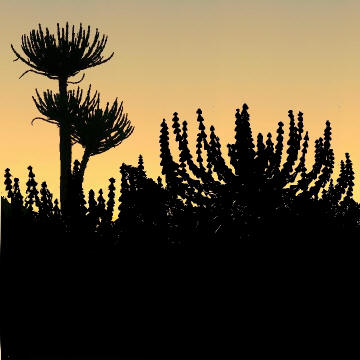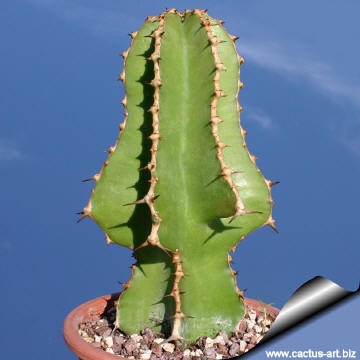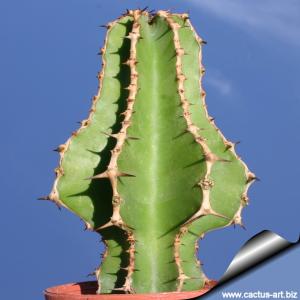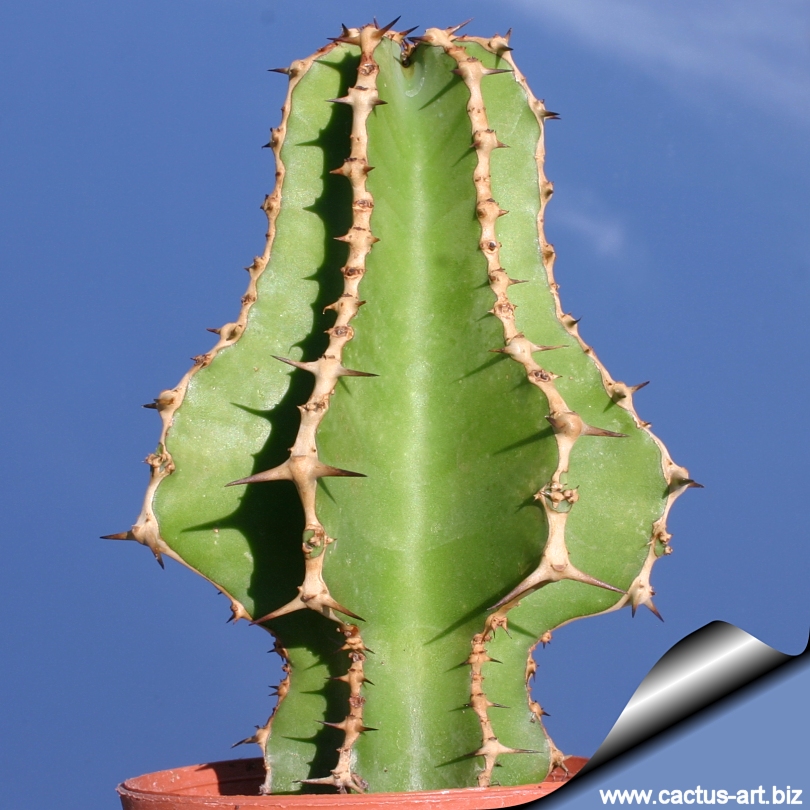-
x
Descrizione
L'Euphorbia cooperi è una delle più caratteristiche fra tutte le specie arborescenti, forma un tronco eretto coronato da rami divisi in segmenti di forma triangolare-cordata. Inconfondibile e affascinante. Family: Euphorbiaceae Accepted scientific name: Euphorbia cooperi N.E.Br. ex A.Berger Origin: South Africa (KwaZulu-Natal , Mpumalanga; Gauteng, Swaziland and up to Messina in Limpopo) The varieties cooperi, calidicola and ussanquensis have been described; only the first one occurs in South Africa, the others are found to the north in other African countries ( Zimbabwe, Zambia, Mozambique, Botswana, Tanzania; Malawi ) Habitat: This tree prefers well-drained soils and is mostly found in rockier places, often on granite outcrops and in rock cracks or in wooded grassland and thorny scrubland. In planes and in steep hillsides on north-facing slopes. Conservation status: Listed in CITES appendix 2.
| |
| Description: Euphorbia cooperi is a spiny, succulent tree 4-7 m tall, with conspicuous candelabra-like branches. The branches do not split again, unlike the common tree Euphorbia. Old dead branches hang underneath the the compact crown for a while. Over time all lower branches sheds in a continual process leaving the top branches to accentuate the candelabra form. | |
 For its beauty and distinctive silhouette nearly all the botanical gardens have one. |  The outer rib-ridges have continuous, narrow and dark spine shields running along the paired spines.ì |
| Cultivation: It is an easy species to grow that is suited for any well drained soil in full sun. But young plant are happy growing indoors. Give the plant an airy growing medium which mainly consists of non organic material such us clay, pumice, lava grit, and only a little peat or leaf-mould. Water regularly during the active growing season from March to September. No water should ever be allowed to stand around the roots. Keep almost completely dry in winter. It is a moderately fast grower, and will quickly become large landscape masterpieces in just 5-10 years. Only downside is from strong winds, the columns often smash into each other, causing permanent scarring... best to plant in such a location where winds are not a big issue. It is a long lived plant and once established, it will be content in its position and with its soil for years. It can tolerate moderate shade, and a plant that has been growing in shade should be slowly hardened off before placing it in full sun as the plant will be severely scorched if moved too suddenly from shade into sun. Like quite small pots, repot in very later winter, early spring. Frost tender, frost free zones only. Propagation: It is easy to propagate by cuttings in late spring to summer, just take a cutting of the plant let it dry for 1 or 2 weeks and stuff it in the ground (preferably dry, loose, extremely well draining soil). Warning: Its latex is reputed the most poisonous in all of the species. Can irritate the skin even if there is proximity and no actual contact, a slight smear on the skin or face produces blisters and inhalation of the air close to a bleeding plant can produce a burning sensation in the throat. Latex irritates the eye and can cause blindeness. If contact is made with this white sap, take care to not touch face or eyes before washing hands with soap and water. Traditional uses: | |


 Euphorbia cooperi is one of the most beautifull of all tree-like euphorbia, characterized by periods of rapid growth, designated by the wide sections, and minimal growth which are the narrow sections.
Euphorbia cooperi is one of the most beautifull of all tree-like euphorbia, characterized by periods of rapid growth, designated by the wide sections, and minimal growth which are the narrow sections.